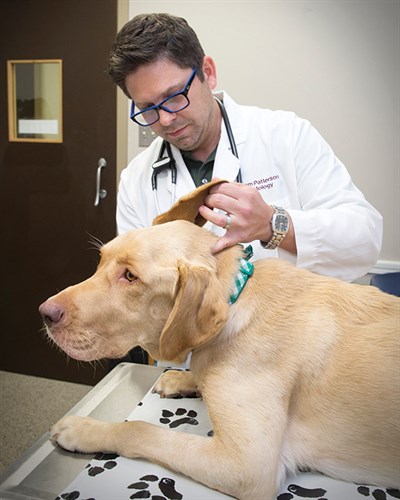Waylon’s Hero: Itching To Make A Difference

When Jill Lee noticed that her Labrador Retriever, Waylon, couldn’t walk and was heavily panting, she immediately knew that something was wrong. After further examination, she discovered that Waylon’s paws and nose were covered in painful scabs and pimples.
“His paws were so itchy that Waylon was literally chewing his paw pads off,” Lee said. “He was causing so much damage to his skin; I was worried for him.”
Fortunately for Waylon, the dermatology service at the Texas A&M College of Veterinary Medicine & Biomedical Sciences (CVM) was there to help. After examining Waylon’s case, Dr. Adam Patterson, clinical associate professor and chief of dermatology at the CVM, concluded that Waylon was experiencing an autoimmune disease of the skin.
“His own immune system was attacking his skin,” Patterson said. “The pimples on his paw pads were extremely painful—he couldn’t even assume the posture to urinate.”
Since Waylon hadn’t urinated prior to arriving at the CVM, his bladder was full, causing more pain. The first thing Patterson did was take Waylon outside, hold him up, and let him urinate. This slowed Waylon’s panting and heart rate to normal levels.
“From there, we just started managing his skin disease, called pemphigus foliaceus,” Patterson said. “It can occur spontaneously for no reason. Occasionally, we believe that it can be triggered by certain drugs or vaccines, but nothing has been fully proven.”
To help Waylon regain his health, Patterson began treating the disease with steroids and a combination of other drugs. Slowly, but surely, Waylon’s condition improved over the course of a few weeks. However, Lee and Waylon still visit the CVM every two weeks for a check-up.
“It’s important that we constantly monitor cases such as Waylon’s,” Patterson said. “When he comes in, we evaluate him and run blood work to see if he is tolerating the drugs in his body. Luckily, Waylon’s condition has improved enough that we are starting to taper the amount of treatment he receives.”
“I’m beyond grateful to Dr. Patterson and his amazing team for the passionate care they continue to provide Waylon,” Lee said. “Fortunately, Waylon is now in remission and I have the honor of bragging about the fantastic care my sweet dog received from the best veterinary dermatologists in the world at Texas A&M.”
Though veterinary dermatologists are trained to treat emergency cases such as Waylon’s, most dermatology cases at the CVM involve health issues with fleas and ticks, skin allergies, and secondary conditions such as bacterial, ear, or yeast infections.
“In dermatology, we’re like allergists are to people,” Patterson said. “Animals can be allergic to many things—including fleas, the food they eat, pollen, grasses, or even indoor things such as house dust and mold. At the CVM, we mainly treat allergic skin and ear disease of dogs, cats, and horses.”
In addition to being examined by a veterinarian, dermatology patients at the CVM are also seen by Doctor of Veterinary Medicine students. This provides a unique and effective environment for treatment, as well as a great learning opportunity for students.
“Our goal at the CVM is to educate the next generation of veterinarians,” Patterson said. “Students are taught to recognize details between different skin diseases so that when they become veterinarians, they’re confident in treating dermatology conditions. In Waylon’s case, I taught students how to differentiate between a skin allergy and an autoimmune disease.”
Since he started at the CVM eight years ago, Patterson said the dermatology service has grown a lot. Between more DVM students enrolling in the dermatology rotation and the first veterinary dermatologist residency at the CVM, Patterson is happy to see the service expand.
“We are able to see more appointments now,” Patterson said. “When I first got here, having one appointment in a day was exciting. Now we see multiple cases in a day, Monday through Friday.”
Whether a patient is having an emergency such as an autoimmune disease or they are experiencing symptoms of a common skin allergy, Patterson and his team are ready to face any condition. With a passion for dermatology and an itch to make a difference, the dermatology service continues to provide excellent care for its patients.
###
For more information about the Texas A&M College of Veterinary Medicine & Biomedical Sciences, please visit our website at vetmed.tamu.edu or join us on Facebook, Instagram, and Twitter.
Contact Information: Megan Palsa, Executive Director of Communications, Media & Public Relations, Texas A&M College of Veterinary Medicine & Biomedical Science; mpalsa@cvm.tamu.edu; 979-862-4216; 979-421-3121 (cell)
This story originally appeared in the Spring 2018 edition of CVM Today magazine.


